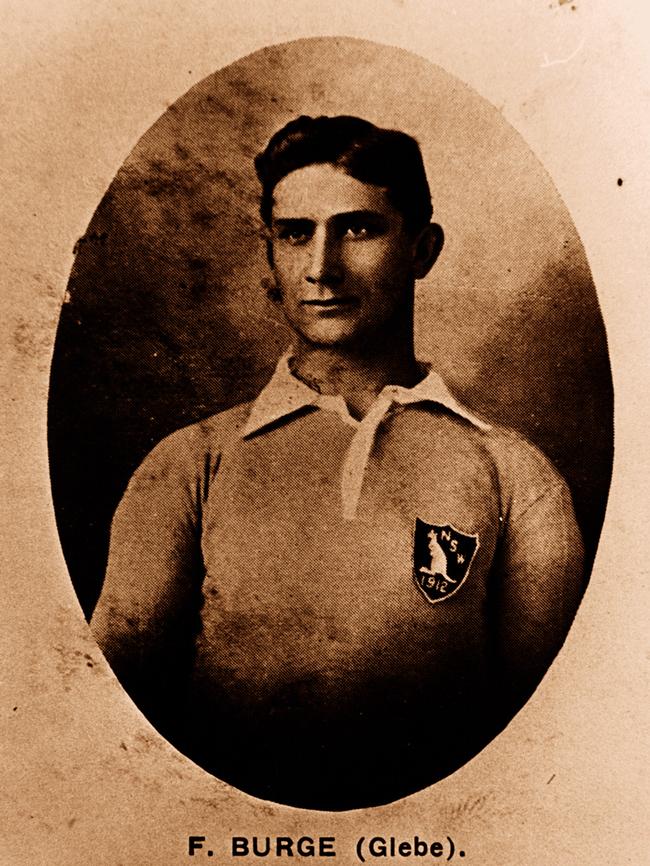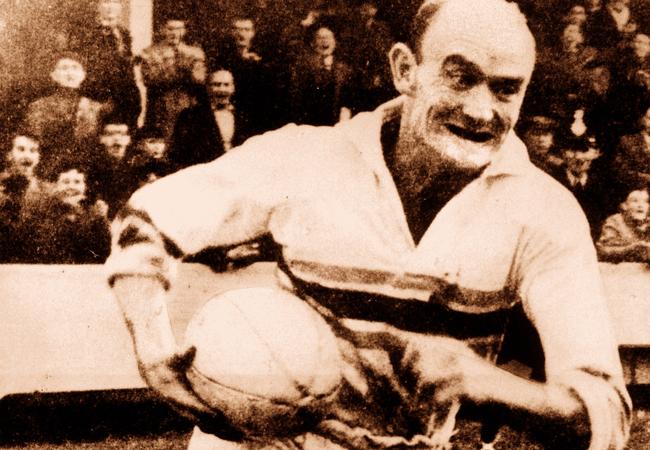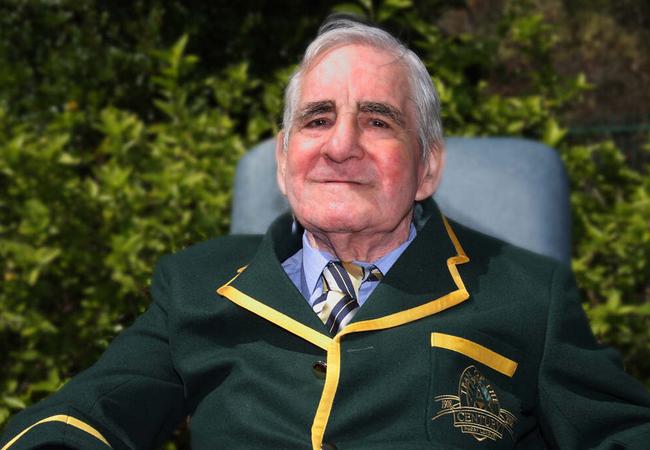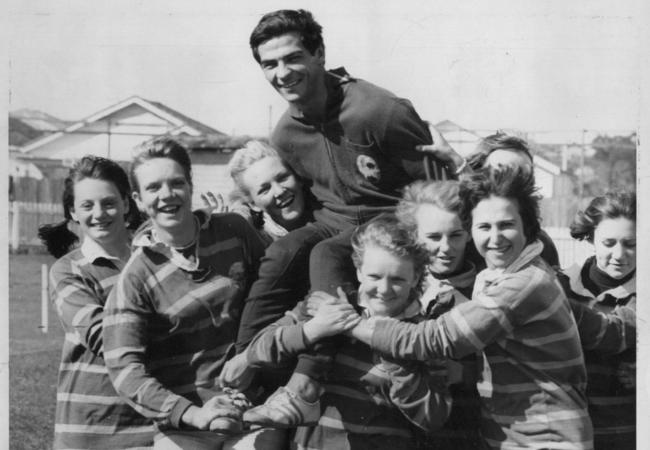Meet the 10 new NRL Immortal candidates
THEY are the greats of the greats. Meet the 10 new candidates for NRL Immortal status, only two of which will reach the pinnacle of rugby league stardom. VOTE IN OUR POLL
NRL
Don't miss out on the headlines from NRL. Followed categories will be added to My News.
PAUL KENT: NRL announces 10 new Immortal candidates
THEY are the greats of the greats. Meet the 10 new candidates for NRL Immortal status.
HERBERT ‘DALLY’ MESSENGER
Position: Centre
Club: Eastern Suburbs 1908–13
Herbert Henry ‘Dally’ Messenger was known throughout rugby league as ‘The Master’. He was the game’s first true champion and helped to secure the future of the fledgling code when he signed on in August 1907. Messenger toured England twice, the first time as the guest of the New Zealand Rugby League and the second as the star member of the First Kangaroos, and such was his reputation that he guaranteed increased gate receipts when English crowds read placards proclaiming that ‘Messenger will be playing’.
Messenger was close to 5ft 8in (172cm) and at his peak in rugby league played at around 12 stone (76kg). Les Cubitt, Kangaroo captain in 1921–22, reckoned he was ‘the equal of any two backs who ever played rugby league’. In 1926, Tom McMahon, the game’s first great referee in Sydney, explained that Messenger was a ‘genius’ on the football field. ‘There was nothing in the game that he could not do well,’ McMahon wrote. ‘Catch, field, side-step, swerve, tackle and kick goals from beyond the halfway mark.’
He was the peerless goalkicker of his day and renowned for his unorthodoxy. He developed the skill of passing the ball over the heads of opponents and regathering, a move which was later outlawed. He is known to have kicked towering goals from his own side of halfway and also to have kicked a field goal against Glebe while one leg was pinned by Glebe’s captain Chris McKivat. Messenger played a pivotal role in Eastern Suburbs’ premiership trilogy in 1911–13, after which his club presented him with the Agricultural Shield.
Club landmarks: Captained Easts to premiership wins 1911–13
Games for NSW: 23 (1908–13)
Games for Qld: 1 (1908)
Tests for Australia: Seven (1908–10) — three as captain
Representative landmarks: Kangaroo tour 1908–09; New Zealand tour of Great Britain 1907–08; Two Tests for New Zealand 1908

FRANK BURGE
Position: Lock/Second row
Clubs: Glebe 1911–23, 1926; Grenfell 1923–25; St George 1927
Frank Burge had few peers when it came to forward play in the early years of rugby league. Time after time over the long years after his retirement, he was called ‘the greatest forward Australia has produced’. Standing at 6ft tall (183cm) and weighing a lean 90kg, Burge set new standards for lock-forward play, and often loomed up in support of his three-quarters after a long break.

Burge scored tries at a phenomenal rate for a forward. He maintained an average of better than a try per game in a career that lasted 17 seasons. He played predominantly for the old Glebe club, but in his final years spent two seasons playing in the Maher Cup with Grenfell before a final season with St George in 1927. Burge established try-scoring records that are never likely to be broken. He holds the record for most tries in a premiership game: eight for Glebe against University in 1920. He scored 33 tries in 23 tour matches for the Kangaroos in 1921–22 and by the end of his career had amassed 218 tries in 213 senior matches.
Burge played 154 games at premiership level. He was a first-grader at 16 and was a strong chance of being chosen for the 1911–12 Kangaroo tour in his first season, but selectors decided he was too young. He later became a respected coach with St George, Easts, Newtown, Canterbury, Wests and Norths. However, despite his wonderful achievements, Burge never won a premiership as either player or coach.
Club landmarks: Holds premiership record for most tries in a game (8); Scored 146 tries in 154 first grade games
Games for NSW: 18 (1912–26)
Tests for Australia: 13 (1914–22)
Representative landmarks: Kangaroo tour 1921–22; Australian tour of New Zealand 1919
DAVE BROWN
Position: Centre
Clubs: Eastern Suburbs 1930–36, 1939–41; Warrington 1937–38
Dave Brown was one of the most prolific pointscorers in rugby league history. His star was at its zenith in the 1930s, the same time as another Australian was rewriting the records in another sphere, and his title as the ‘Bradman of League’ was testament to his abilities.
As a youngster, Brown overcame a series of horrific injuries and mishaps to make his mark in the game. He had lost the top of a thumb as a toddler, broke an arm and dislocated his elbow in a schoolyard accident, and was badly scalded by water at home. As an 18-year-old, he lost all of his bodily hair due to illness. But when he donned the brown leather headgear that was to become his trademark, Brown developed into one of rugby league’s greatest champions. He smashed the Kangaroo tour point-scoring record in 1933–34 with 285 points, a tally that is not likely to be approached. And in the mid-1930s he was a giant figure in Eastern Suburbs’ premiership wins in 1935–36–37. His premiership records of 38 tries in a season and 45 points in one match, both achieved in 1935, stand to this day. In all games that year he scored 385 points, and was captain in every game he played, at age 22.
Frank Hyde wrote of Brown: ‘He was a master at backing up. If a ball was dropped he’d swoop on it like a shark homing in on a mackerel.’
Club landmarks: Won premierships with Easts 1935–36, 1940
Games for NSW: 21 (1931–36)
Tests for Australia: Nine (1933–36) — six as captain
Representative landmarks: Kangaroo tour 1933–34 (scoring record 285 points); Australia’s youngest Test captain
BRIAN BEVAN
Position: Wing
Clubs: Eastern Suburbs 1942–46; Warrington 1945–62; Blackpool Borough 1962–64
‘There are wingers and there are great wingers,’ Arthur Clues, Test second-rower in 1946, once declared. ‘Then, way out beyond them all, is Brian Bevan.’ Born in Sydney’s eastern suburbs, Bevan left for England early in his career where, through sheer volume of tries, he rose to legendary status. The prematurely balding, wiry-framed, knee-bandaged Bevan looked anything but a tryscoring machine, but his opponents would testify otherwise. He consistently made fools of opposing defences with his armoury of attacking skills.
Bevan was devoted to physical fitness years before such intense training regimes were introduced to the game, which helps explains how he accumulated a monumental career tally of 796 tries from 688 appearances in English football. His total is an incredible 275 tries ahead of the second player on the all-time list: Billy Boston. Bevan was graded by Easts in 1941, and made seven first-grade appearances the following season and another one in 1946; navy service did limit his involvement, but, ironically, his only score in top-grade rugby league in Australia was a goal.
He signed a contract worth £300 with Warrington late in 1945, and repaid the club many times over in the 17 seasons that followed. He wound up his career with two seasons at Blackpool, and even though he was approaching his 40th birthday, Bevan still managed 17 tries in 42 appearances. Later, he became the first player to be inducted into Halls of Fame in both England and Australia.
Club landmarks: Won Challenge Cups with Warrington 1950 and 1954; Scored world record 796 career tries
Representative landmarks: Played 16 times for Other Nationalities (1949–55)

DUNCAN HALL
Position: Prop
Clubs: Christian Brothers Rockhampton 1945–47; Brisbane Valleys 1948–49; Home Hill 1950; Newtown, Toowoomba 1951–52; Brisbane Wests 1954–57
Queensland-born Duncan Hall has long been regarded as one of Australia’s greatest post-war front-rowers. He rose to prominence in the period immediately following World War II, toured twice with the Kangaroos and played in two Ashes-winning series for Australia.
Hall had accepted a playing position at Alpha in Central Queensland in the mid-1940s, but a railway strike meant he was unable to take up the position, and instead he moved to Brisbane, where he linked up with the Valleys club. From there he made a meteoric rise to representative football, first with Brisbane, then Queensland and in little more than three months he was selected in Australia’s Test side to play New Zealand.
Hall became a mainstay of Australian teams for the next seven years, contributing mightily to Australia’s Ashes triumphs in 1950 and 1954. Hall played his entire domestic career in Queensland, moving from Valleys back to his home town of Home Hill in 1950, before stints in Toowoomba and with Brisbane Wests. A knee injury cost him the opportunity of a third Kangaroo tour in 1956.
‘Hall had an equal distribution of brawn and brains which put him in the near genius class,’ Duncan Thompson wrote. ‘There certainly never was a better ball distributor. Whatever a champion prop needed, Duncan Hall had. He was surprisingly fast and truly tough.’
Club landmarks: Won Brisbane premiership with Wests 1954
Games for Qld: 24 (1948–55)
Tests for Australia: 22 (1948–55)
World Cup matches: One (1954)
Representative landmarks: Kangaroo tours 1948–49, 1952–53; World Cup 1954

NORM PROVAN
Position: Second row
Club: St George 1951–65
Norm Provan was a giant of the game in every respect. Apart from his imposing stature (he stood 193cm), Provan was a towering figure for St George in their record run of premiership wins and for Australia in 18 Test and World Cup appearances. At Test level, he formed one of Australia’s most revered back-row partnerships with Queensland and later Western Suburbs second-rower Kel O’Shea.

It was Provan’s efforts for St George that helped cement his legend in the game. He played in 10 of St George’s 11 successive grand-final victories, the last five as captain-coach. He bowed out in 1965, when the Dragons triumphed 12–8 over Souths in front of 78,056 spectators.
In 1957, EE Christensen wrote how Provan with his stellar performances had gained for himself ‘a niche in rugby league history along with the Burges, Pearces, Treweekes (sic) and Narvos … Provan’s crashing runs were a feature of the World Cup and, never a shiner, he was just as hard with his tackling as he was brilliant in attack.’
Provan was born in the NSW Riverina, went to school in the North Sydney district, and trialled unsuccessfully with Eastern Suburbs before joining St George from the Sutherland juniors. ‘Provan was born to lead,’ wrote Ian Heads in March of the Dragons. ‘His honesty, ambition, will to win, courage, dignity, modesty, pride in achievement, loyalty and fair play fitted him perfectly for the task.’
Club landmarks: Won premierships with St George 1956–65; Captained St George to premiership wins 1962–65
Games for NSW: 25 (1954–61)
Tests for Australia: 14 (1954–60)
World Cup matches: Four (1954–57)
Representative landmarks: Kangaroo tour 1956–57; World Cups 1954, 1957
KEN IRVINE
Position: Wing
Clubs: North Sydney 1958–70; Manly 1971–73
Ken Irvine was the fastest player of his age. He was a dynamic, athletic try-scoring machine whose place in league’s Hall of Fame will never be disputed. Irvine maintained his place at the highest level of the game for a decade by sheer weight of tries. His tally of 212 premiership tries is almost 50 tries more than second-best and his final count of 33 tries in 31 Test matches is another record that is likely to stand the test of time.
Ironically, it is a single goal that Irvine is remembered for more than almost any of his phenomenal tally of 356 career tries. It came in the third Test of 1962 when he landed a goal from the sideline to give Australia a face-saving 18–17 victory over Great Britain.
It is said that Norths’ official Tom Hicks saw Irvine in action in a sports carnival when he was 14 and declared, ‘If ever I saw a champion on the way, it’s this kid … He has everything.’ Irvine played for 13 seasons with the North Sydney club and scored 171 tries from 176 games, a stunning achievement considering Norths were moderate performers for much of that period. Irvine left the club in search of a premiership at neighbouring Manly late in his career and featured in back-to-back grand final wins in 1972 and 1973. Irvine toured three times with the Kangaroos and remained one of league’s most popular figures until his death in 1990.
Club landmarks: Won premierships with Manly 1972–73; Scored premiership record 212 tries in 236 premiership games
Games for NSW: 30 (1950–67)
Tests for Australia: 31 (1959–67)
World Cup matches: Two (1960)
Representative landmarks: Kangaroo tours 1959–60, 1963–64, 1967–68; World Cup 1960; Australia tours of New Zealand 1961, 1965; Scored record 33 Test tries for Australia

RON COOTE
Position: Lock/Second row
Clubs: South Sydney 1964–71; Eastern Suburbs 1972–78
Lock forward Ron Coote played the early years of his career in the shadow of an Immortal. From his debut with South Sydney in 1964, the rangy Coote was hailed as the heir apparent to the great Johnny Raper. A tall and gifted athlete, Coote possessed many of Raper’s qualities — he was a superb cover-defender and fast and powerful with the ball in hand. Most pundits considered it only a matter of time before he stepped into Raper’s boots. However, it was a long time coming. Raper continued to hold his place in the Australian side until 1968, but Coote’s form was too good to ignore and selectors made room for him in the second row.
In 1969 and 1970, Coote made the Australian lock forward position his own. He was named Harry Sunderland Medal winner in 1970 as Australia’s best player during the Ashes series and later the same year captained Australia to World Cup triumph in England. Business and family commitments and then injury kept him out of the Australian side over the next three seasons, but in 1974 he made up for lost time, winning a second Sunderland Medal as he helped guide Australia to the Ashes.
Coote also made a huge impact on club football, playing in nine grand finals in the space of 11 seasons with Souths and Easts. He won four titles with Souths, two with Easts, and became the first player to appear in 100 premiership matches for two separate clubs.
Club landmarks: Won premierships with Souths 1967–68, 1970–71; Won premierships with Easts 1974–75
Games for NSW: 15 (1965–75)
Tests for Australia: 13 (1967–74)
World Cup matches: 10 (1968–75) — three as captain
Representative landmarks: Kangaroo tour 1967–68; World Cups 1968, 1970; Captained Australia to World Cup win 1970; World Series 1975

MAL MENINGA
Position: Centre
Clubs: Souths Brisbane 1979–85; St Helens 1984–85; Canberra 1986–94
Mal Meninga’s endless list of records and achievements stands as a testament to the strength and perseverance he displayed over a magnificent 17-year career in top level football. The former police cadet burst onto the scene with Souths in Brisbane in 1978 and was a Queensland representative the following season and an Australian rep soon after his 22nd birthday.
Meninga had been blessed with size and strength and used those qualities to their fullest. He is the only player to tour four times with the Kangaroos and the only player to make two Kangaroo tours as captain. And he achieved much of this after he withstood the pain and frustration of four broken arms during the 1987–88 seasons.
Meninga recovered from the setbacks as a more mature and more consistent player. ‘The true test of a champion is not just what he does as an individual,’ said Bob Fulton of Meninga. ‘It’s what he does for the players around him.’ Meninga was renowned for charges through the defence, and captained Canberra to three premiership wins. Perhaps his most memorable performance came at Old Trafford in 1990, when he helped Australia to salvage the Ashes with a barnstorming try in the final minutes of the second Test.
Club landmarks: Won Brisbane premierships with Souths 1981, 1985; Captained Canberra to premiership wins 1989–90, 1994
Games for Qld: 42 (1979–84; includes 32 State of Origins 1980–94)
Tests for Australia: 45 (1982–94) — 23 as captain
World Cup matches: One (captain)
Representative landmarks: Kangaroo tours 1982, 1986, 1990 (captain), 1994 (captain); The only player to tour four times with the Kangaroos; Holds records for most Tests for Australia, most points for Australia, most appearances for Queensland and most points for Queensland

DARREN LOCKYER
Position: Fullback/Five-eighth
Club: Brisbane Broncos 1995–2011
Darren Lockyer is a Roma lad, who was discovered by the Broncos’ super talent scout Cyril Connell. Like most true champions, Lockyer stood out from an early age — a product of the Queensland under-age teams, he played first grade at the Broncos in 1995 at 18 years of age, as a five-eighth.
His exceptional skills marked him as something special. He had great hands, could both punt and place-kick, was sure under the high ball, was deceptively fast, having an ability to go up a gear as he went for an opening, and he could tackle. He also never lost that shyness and modesty characteristic of many country people.
Perhaps 2003 was Lockyer’s most sensational year, as he won the player-of-the year award at the Broncos and led the Kangaroos, only the fourth Queenslander to do so, after Tom Gorman, Wally Lewis and Mal Meninga.

One of the features of his play was his consistency, as well as the ability to rise to the occasion. He won the Clive Churchill Medal in 2000, and in 2006 led the Broncos to the premiership, Queensland to an Origin series, and Australia to victory in the Tri-Nations tournament. The all-round nature of Lockyer’s game was seen in 2004, when he moved from fullback, where he played most of his football during the previous seven seasons, to five-eighth, and handled the switch with aplomb.
He played 17 seasons at the top level, continuing until 2011 when he led Queensland to a sixth consecutive State of Origin series victory and Australia to Four Nations success in England. He retired as the most capped player in Origin history (36 games) and as Australia’s most capped player (59 Tests) and captain (38 Tests).
Perhaps his greatest accomplishment may have been in earning Golden Boot awards (recognition as the best player in the world) in two positions – as fullback (2003) and five-eighth (2006).
Club landmarks: Won premierships with Brisbane 1997–98, 2000, 2006 (captain); Holds Brisbane club record for most appearances (355); and most points in a season (272);
Games for Qld: 38 (1997–2011; includes 36 State of Origins 1998–2007);
Tests for Australia: 59 (1998–2011) — 38 as captain
World Cup matches: Nine (2000, 2008)
Representative landmarks: Kangaroo tours 2001, 2003 (captain); World Cup 2000, 2008 (captain); Tri-Nations tours 2004–05; 2009, 2011 (captain)
